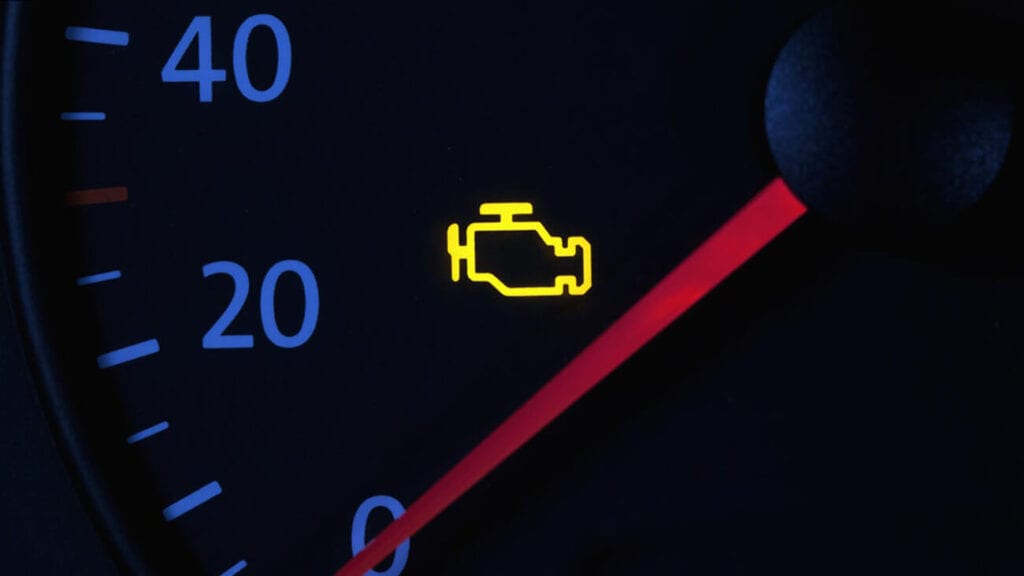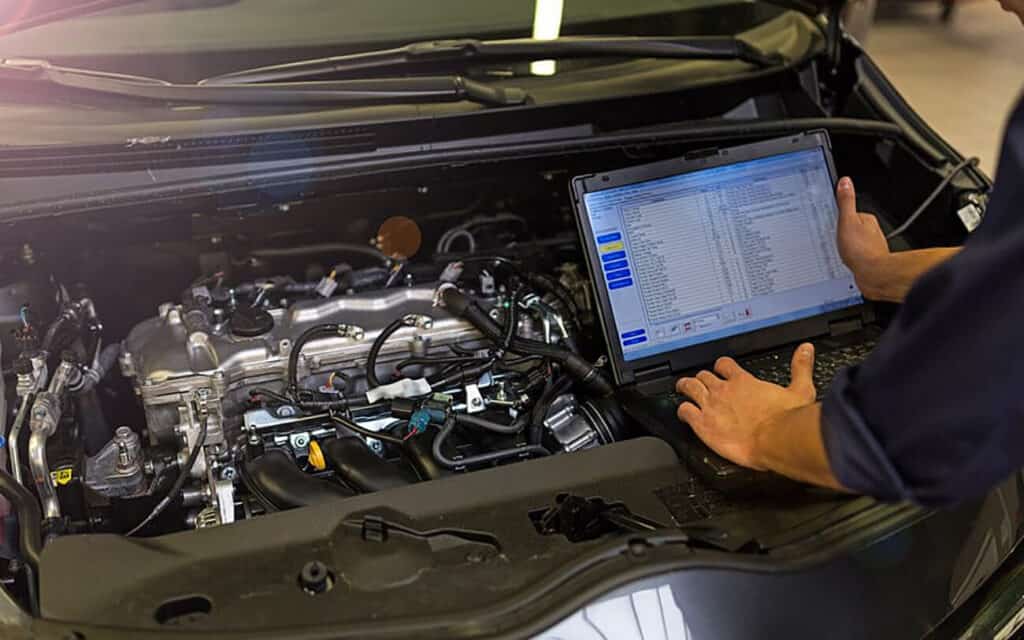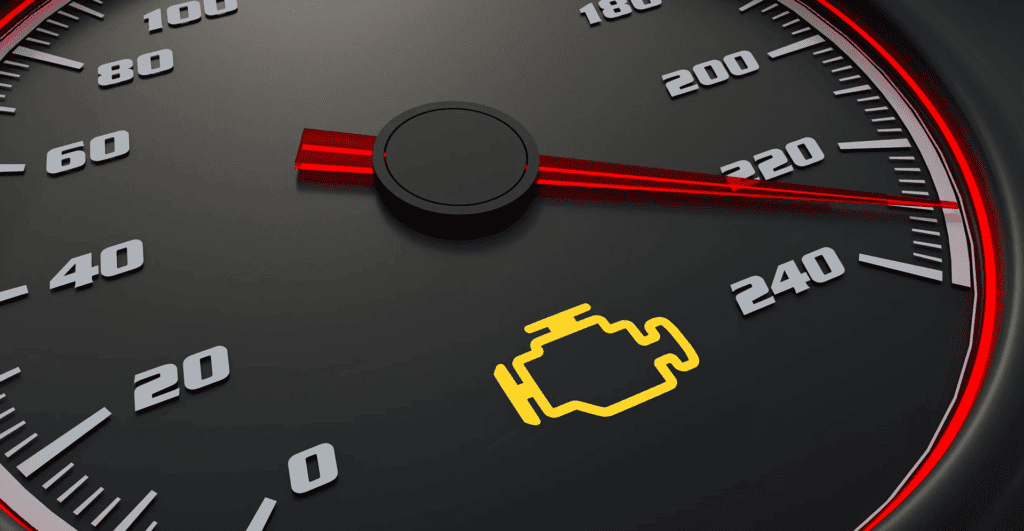Navigating the Illuminated Highway
Embark on a journey through the intricate circuits and systems of your vehicle, starting with that mysterious and sometimes daunting check engine light.
Unmasking the Glow: Understanding the Check Engine Light
Cruising along Ontario’s roads, it’s easy to overlook the myriad of symbols and indicators on your car’s dashboard. But among them, there’s one that often raises eyebrows and quickens heartbeats: the check engine light. With its orange-yellow hue, it stands out, and for a good reason. It’s not there merely as an ornamental addition. Instead, it’s a sentinel, keeping a vigilant watch over the intricate workings of your vehicle, ever ready to announce any discrepancies.
When this particular luminary shines solidly, it’s akin to a friend gently tapping your shoulder, saying, “Hey, something’s caught my attention.” It’s not a frantic alarm bell but rather a nudge, suggesting you to take a closer look. It might be a minor hiccup or an early sign of something that needs addressing. But the underlying message? “No need for immediate panic, but let’s check this out when you get a moment.”

Onboard Diagnostics: Your Car’s Way of Talking to You
In the vast orchestra of moving parts, sensors, and circuits, your car has found a way to communicate its health status to you, much like a patient describing symptoms to a doctor. The onboard diagnostic system is that voice, and its lexicon is comprehensive. When something seems off or a component isn’t performing optimally, it sends out an alert.
Now, imagine the check engine light as a crucial word in this vehicular language. It’s the equivalent of a fever in humans — a general sign indicating that something’s amiss. While it might not tell you exactly what’s wrong, it’s a beacon prompting you to dig deeper, to translate its message. Listening attentively can be the difference between a quick fix and a costly repair.
A Simple Start: The Gas Cap Theory
In the myriad of complexities that modern vehicles encompass, there exists a humble component, often overlooked but essential: the gas cap. To the average driver in Ontario, it may seem insignificant, but its role in ensuring optimal performance and preventing fuel evaporation is crucial.
So, it might come as a surprise to many that sometimes, the glaring check engine light is merely raising an alarm about this little component being loose or not sealed correctly. It’s like misplacing your glasses and realizing they’ve been on your head the entire time. Before diving into intricate diagnostics or fearing the worst, ensure your gas cap is secure. You might just find the simple solution to the glowing mystery on your dashboard.
Common Culprits: Frequent Reasons Behind the Glow
Low Oil Levels
• Significance: Oil is the lifeblood of the engine, providing necessary lubrication and reducing friction.
• Impact: Low oil can lead to increased engine wear, reduced efficiency, and in severe cases, engine damage.
• Solution: Regularly check and replenish oil levels, and consider scheduled oil changes.
Oxygen Sensors
• Purpose: Measure the amount of unburned oxygen in the vehicle’s exhaust system.
• Impact: A malfunctioning sensor can reduce fuel efficiency and increase emissions.
• Solution: Replacement of the sensor, typically every 60,000 to 100,000 km.
Loose Gas Cap
• Impact: Evaporative emissions can escape, and the fuel system can be exposed to outside debris.
• Solution: Simple tightening or replacement if the cap is damaged.
Faulty Catalytic Converter
• Purpose: Convert harmful carbon monoxide and other pollutants into less harmful emissions.
• Impact: Reduced engine performance and increased emissions.
• Solution: Replacement, though it can be expensive.
Malfunctioning Mass Air Flow Sensor
• Purpose: Measure the amount of air entering the engine to determine how much fuel is needed.
• Impact: Reduced fuel efficiency and performance.
• Solution: Cleaning or replacement, usually recommended every 50,000 km.
Safe Cruising or Immediate Pit Stop? Deciding When to Drive
Every motorist in Ontario knows the feeling: you’re smoothly cruising along the highway, perhaps enjoying a podcast or the scenic beauty, when suddenly, the dreaded check engine light illuminates on your dashboard. A steady glow suggests a hint of caution but doesn’t scream emergency. Think of it as the aftermath of stubbing your toe — it’s uncomfortable, definitely warrants attention, but you can still soldier on for a short while.
However, a blinking check engine light changes the game entirely. It’s your car’s desperate cry for help, reminiscent of that agonizing pain from a sprained ankle. Continuing to drive in this state isn’t just risky; it can cause long-term damage, potentially escalating repair costs. Just as you’d immediately halt any activity on a sprained ankle, it’s crucial to pull over safely when that light starts flashing. Prioritizing your vehicle’s health ensures you can keep enjoying those serene drives without unexpected interruptions.

“It’s Just a Phase” – Temporary Glitches vs. Serious Alarms
Transient Errors
• Examples: Loose gas cap, short-term sensor malfunctions due to extreme weather conditions.
• Indication: The check engine light might blink or illuminate intermittently.
• Solution: Address the root cause; sometimes the issue might resolve on its own, like after tightening the gas cap.
Reoccurring or Continuous Illumination
• Significance: Indicates a persistent issue that might not resolve without intervention.
• Common Causes: Faulty sensors, emission system issues, and more complex engine problems.
• Solution: A diagnostic scan is essential to pinpoint the problem, followed by a professional consultation.
Flashing vs. Steady Light
• Flashing: Often indicates a severe issue requiring immediate attention, like a misfire that can damage the catalytic converter.
• Steady: Suggests a less urgent issue, though it’s still essential to get it checked.
Self-Resolution of Issues
• Occurrence: Some minor issues might trigger the light, but the system might correct them without intervention.
• Advice: Even if the light goes off by itself, consider getting a diagnostic scan to ensure there aren’t underlying issues.
Decoding the Signals: Diagnostic Tools and Professionals
Modern problems require modern solutions. Diagnostic tools can help translate your car’s signals, or you could turn to the experts for a more in-depth consultation.
Onboard Diagnostic Systems (OBD)
• Origin: Introduced in the 1980s, these systems have become the standard for vehicle diagnostics.
• Function: Reads the data from the vehicle’s computer, pinpointing issues related to the engine, transmission, exhaust, and more.
• Accessibility: OBD ports are usually located under the dashboard, and with the right tool (often called a “scanner” or “reader”), you can access the codes the system generates.
Diagnostic Code Translation
• Code Structure: Each code is a combination of letters and numbers, with each segment indicating a specific issue or area in the vehicle.
Examples
“P0401” may indicate an exhaust gas recirculation issue.
“P0442” can suggest a small leak in the evaporative emission control system.
• Solutions: While online databases can provide interpretations, for a comprehensive understanding, consulting a professional is ideal.
Professional Assistance
• Expertise: Mechanics undergo rigorous training and certification to understand and rectify a wide range of automotive issues.
• Consultation: An expert can not only decode the issue but also suggest preventative measures for the future.
• Recommendation: For those not keen on DIY solutions or when faced with complex issues, turning to professionals like Uchanics is a prudent choice.

Repair Roadmap: Potential Fixes and Cost Breakdown
From simple remedies to more extensive fixes, it’s crucial to understand the path forward and potential costs involved:
Basic Fixes
• Gas Cap Tightening: Sometimes the simplest solution like securing a loose gas cap can turn off that check engine light.
Intermediate Repairs
• Sensor Replacements: Parts like the oxygen sensor or mass airflow sensor might need replacement.
• Spark Plug Changes: These small components can cause significant problems if worn out.
• Cost: Can range from $50 to $300, depending on the issue and the model of the car.
Advanced Repairs
• Catalytic Converter Replacement: A crucial part of the vehicle’s exhaust system, ensuring harmful emissions are converted into less harmful gasses.
• Transmission Issues: More complex and can range from fluid replacements to complete overhauls.
• Cost: These can be on the higher side, ranging from $400 to over $3,000 based on the problem’s extent.
Seeking Quotes and Estimates
• Importance: Always get a detailed breakdown of the repair costs.
• Transparency: Ensure no hidden fees are lurking in the final bill.
• Comparison: It’s advisable to get multiple quotes, but also consider the reputation and expertise of the service provider.
Embrace the Glow, Don’t Fear It
The check engine light is a car’s way of keeping you safe and informed. Whenever in doubt, reach out to the professionals. Uchanics is a trusted mobile mechanic company in Canada that ensures your drive remains smooth. Ready for a hassle-free experience? Book an appointment today!
